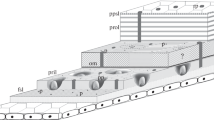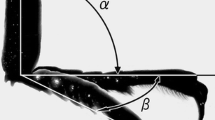Summary
-
1.
The cuticle of the walking legs of adult spiders (Cupiennius salei Keys.) was examined by both the light- and electron microscope.
-
2.
The following layers can be distinguished from the surface inward: epi-, exo-, meso-, endo-, and subcuticle. Although various stains used in light microscopy show the meso- and endocuticle are not identical, the electron microscope reveals no clear difference between them.
-
3.
The epicuticle is less than 0,5 μ thick and with a wavy surface resulting from riblike elevations (height and width about 1500 Å). The sequence of the 5 layers composing the epicuticle as they appear under the electron microscope suggests that these are homologous to the layers found in insects. It is therefore proposed to call them dense layer (1), cuticulin layer (2), oriented lipid layer (3, 4), and cement layer (5) respectively.
-
4.
Microfibers can be seen in the meso- and endocuticle as well as in the exocuticle. Whereas curved patterns appear on sections parallel to the longitudinal axis of the leg, only horizontal bands of alternating degrees of electron density can be observed on cross sections.
-
5.
The cuticular components of the various sensilla located in the cuticle of the spider leg are mainly made up of exocuticle; their characteristics are illustrated.
-
6.
Sections reveal pore canals which extend outwards through all levels of the cuticle. Within the dense layer of the epicuticle they branch into about 10 canals of greatly reduced diameter. These almost always terminate between a pair of epicuticular ribs, and some appear to remain open after penetrating the oriented lipid layer. There is evidence that the course of the pore canals is not straight but curved, forming arches between two neighbouring laminae.
-
7.
According to the results so far obtained from the legs there are no basic differences between the cuticle of a spider and an insect.
Zusammenfassung
-
1.
Die Cuticula des Laufbeines adulter häutungsferner Spinnen (Cupiennius salei Keys.) wird licht- und erstmals auch elektronenmikroskopisch untersucht.
-
2.
Von außen nach innen lassen sich Epi-, Exo-, Meso-, Endo- und eine lückenhafte Subcuticula voneinander unterscheiden. Meso- und Endocuticula unterscheiden sich hinsichtlich ihres Verhaltens gegenüber in der Lichtmikroskopie verwendeten Farbstoffen, jedoch konnten keine elektronenoptischen Unterschiede festgestellt werden.
-
3.
Die Epicuticula ist weniger als 0,5 μ dick, trägt rippenartige Erhebungen von ca. 1500 Å Höhe und etwa ebensolcher Breite; sie besteht aus verschiedenen Lagen, deren Aufeinanderfolge und elektronenoptisches Aussehen den Schluß nahelegen, daß es sich dabei wie bei den Insekten von innen nach außen um „dense layer“, Cuticulinschicht, orientierte Lipidschicht und Zementschicht handelt.
-
4.
Sowohl in Meso- und Endocuticula als auch in der Exocuticula sind Mikrofasern zu erkennen. Auf Querschnitten des Beines fällt nur das regelmäßige Aufeinanderfolgen von oberflächenparallelen elektronenoptisch hellen und dunkleren Zonen auf. Auf Schnitten dagegen, die parallel zur Längsachse des Beines verlaufen, erscheinen charakteristische Bogenmuster.
-
5.
Die Exocuticula ist wesentlich am Aufbau der für das Laufbein typischen Cuticularsensillen beteiligt; die Eigentümlichkeiten des cuticularen Anteils von Trichobothrien und anderen Borstensensillen, Spaltsinnesorganen und dem Tarsalorgan werden illustriert.
-
6.
Porenkanalanschnitte finden sich in allen Cuticulazonen, in abgewandelter Form auch in der Epicuticula: Zwischen zwei Epieuticularrippen geht der Porenkanal in der „dense layer“ in etwa zehn ca. 1100 Å breite Kanälchen über, die zumindest teilweise nach Durchdringen der orientierten Lipidschicht offen enden. Die Porenkanäle ziehen nicht gestreckt durch die Cuticula, sondern bilden jeweils zwischen zwei Laminae einen Bogen.
-
7.
Die Feinstruktur der Spinnencuticula zeigt nach den bisherigen Untersuchungen am Laufbein keine prinzipiellen Unterschiede zu der Insektencuticula.
Similar content being viewed by others
Literatur
Adam, H. und G. Czihak: Großes Zoologisches Praktikum, Teil I Arbeitsmethoden. Stuttgart: Gustav Fischer 1964.
Barth, F. G.: Ein einzelnes Spaltsinnesorgan auf dem Spinnentarsus: seine Erregung in Abhängigkeit von den Parametern des Luftschallreizes. Z. vergl. Physiol. 55, 407–449 (1967).
-, u. N. Deutschländer: Der Bau eines Einzelspaltsinnesorgans auf dem Tarsus der Spinne Cupiennius salei Keys. Mém. Mus. nat. Hist. natur. (Paris) (im Druck).
Blumenthal, H.: Untersuchungen über das Tarsalorgan der Spinnen. Z. Morph. Ökol. Tiere 29, 667–719 (1935).
Bouligand, Y.: Sur une architecture torsadée répondue dans de nombreuses cuticles d'arthropodes. C. R. Acad. Sci. (Paris) 261, 3665–3668 (1965).
Browning, H. C.: The integument and moult cycle of Tegenaria atrica (Araneae). Proc. roy. Soc. 131, 65–86 (1942).
Eckert, M.: Experimentelle Untersuchungen zur Häutungsphysiologie der Spinnen. Zool. Jb. Abt. allg. Zool. u. Physiol. 73, 49–101 (1967).
Gluud, A.: Zur Feinstruktur der Insektencuticula. Ein Beitrag zur Frage des Eigengiftschutzes der Wanzencuticula. Zool. Jb., Abt. Anat. u. Ontog. 85, 191–227 (1968).
Görner, P.: A proposed transducing mechanism for a multiply-innervated mechanoreceptor (trichobothrium) in spiders. Sensory receptors. Cold Spr. Harb. Symp. quant. Biol. 30, 69–73 (1965).
Hackmann, R. H.: Chemistry of the insect cuticle. In: The physiology of insecta, (M. Rockstein, ed.), vol. 3, p. 471–502. New York: Academic Press Inc. 1964.
Hoffmann, C.: Bau und Funktion der Trichobothrien von Euscorpius carpathicus L. Z. vergl. Physiol. 54, 290–352 (1967).
Krishnakumaran, A.: A comparative study of the arachnid cuticle. II. Chemical nature. Z. vergl. Physiol. 44, 478–486 (1961).
—: A comparative study of the cuticle in Arachnida. I. Structure and staining properties. Zool. Jb., Abt. Anat. u. Ontog. 80, 49–64 (1962).
Locke, M.: Pore canals and related structures in insect cuticle. J. biophys. biochem. Cytol. 10, 589–618 (1961).
—: The structure and formation of the integument in insects. In: The physiology of insecta (M. Rockstein, ed.), p. 379–470. New York: Academic Press Inc. 1964.
Melchers, M.: Zur Biologie und zum Verhalten von Cupiennius salei (Keyserling), einer amerikanischen Ctenide. Zool. Jb., Abt. System., Ökol. u. Geogr. 91, 1–90 (1963).
—: Der Beutefang von Cupiennius salei (Keyserling) (Ctenidae). Z. Morph. Ökol. Tiere 58, 321–346 (1967).
Nemenz, H.: Über den Bau der Kutikula und dessen Einfluß auf die Wasserabgabe bei Spinnen. S.-B. öst. Akad. Wiss., math.-nat. Kl., Abt. I 164, 65–76 (1955).
—: Die Kutikula und Kutikularstrukturen von Gasteracantha cancriformis (L. 1758) (Araneae, Araneidae, Gasteracanthinae). Z. wiss. Zool. 169, 82–114 (1963).
Neville, A. C.: Chitin orientation in cuticle and its control. In: Advances in insect physiology, (J. W. L. Beament, J. E. Treherne, and V. B. Wigglesworth, ed.), vol. 4, p. 213–286. London and New York: Academic Press Inc. 1967.
Noble-Nesbitt, J.: The cuticle and associated structures of Podura aquatica at the moult. Quart. J. micr. Sci. 104, pt. 3, 369–391 (1963).
—: The fully formed intermoult cuticle and associated structures of Podura aquatica (Collembola). Quart. J. micr. Sci. 104, pt. 2, 253–270 (1963).
—: Aspects of the structure, formation and function of some insect cuticles. In: Insects and physiology (J. W. L. Beament, and J. E. Treherne, ed.). Edinburgh and London: Oliver & Boyd 1967.
Peters, W.: Die Feinstruktur der Kutikula von Atemorganen einiger Arthropoden. Z. Zellforsch. 93, 336–355 (1969).
Rathmayer, W.: Methylmethacrylat als Einbettungsmedium für Insekten. Experientia (Basel) 18, 47–48 (1962).
Richards, A. G.: Sclerotization and the localization of brown and black colors in insects. Zool. Jb. Anat. 84, 25–62 (1967).
—, and T. F. Anderson: Electron microscope studies of insect cuticles. J. Morph. 71, 135–183 (1962).
Romeis, B.: Mikroskopische Technik. München: R. Oldenbourg 1948.
Salpeter, M. M., and Ch. Walcott: An electron microscopical study of a vibration receptor in the spider. Exp. Neurol. 2, 232–250 (1960).
Schmidt, E. L.: Observations on a subcuticular layer in the insect integument. J. Morph. 99, 211–232 (1956).
Seitz, K. A.: Untersuchungen über dynamische Vorgänge im Ei der Spinne Cupiennius salei (Ctenidae) mittels Röntgen-Barrieren. Zool. Jb., Abt. Anat. u. Ontog. 84, 343–374 (1967).
Sewell, M. T.: Pore canals in a spider cuticle. Nature (Lond.) 167, 857 (1951).
—: The histology and histochemistry of the cuticle of a spider. Tegenaria domestica (L.). Ann. entomol. Soc. Amer. 48, 107–118 (1955).
Sjöstrand, F. S.: Electron microscopy of cells and tissues. Vol. I: Instrumentation and techniques. New York and London: Academic Press 1967.
Wigglesworth, V. B.: The structure and deposition of the cuticle in the adult mealworm Tenebrio molitor. Quart. J. micr. Sci. 89, 197–217 (1948).
Author information
Authors and Affiliations
Additional information
Mit Unterstützung durch die Deutsche Forschungsgemeinschaft.
Der elektronenmikroskopische Teil dieser Arbeit konnte dank der Gastfreundschaft von Herrn Prof. Dr. E. Dahme und der Einweisung in die elektronenmikroskopischen Techniken durch Herrn Dr. N. Deutschländer im Institut für Onkologie und Neuropathologie der tierärztlichen Fakultät durchgeführt werden.
Für Kritik danke ich Herrn Prof. Dr. Dr. h. c. H. Autrum, Herrn Dr. R. Loftus, meinem Bruder und Herrn Prof. Dr. H. Altner und für Hilfe bei der Fertigstellung des Manuskriptes meiner Frau.
Rights and permissions
About this article
Cite this article
Barth, F.G. Die Feinstruktur des Spinneninteguments. Z. Zellforsch. 97, 137–159 (1969). https://doi.org/10.1007/BF00331877
Received:
Issue Date:
DOI: https://doi.org/10.1007/BF00331877




